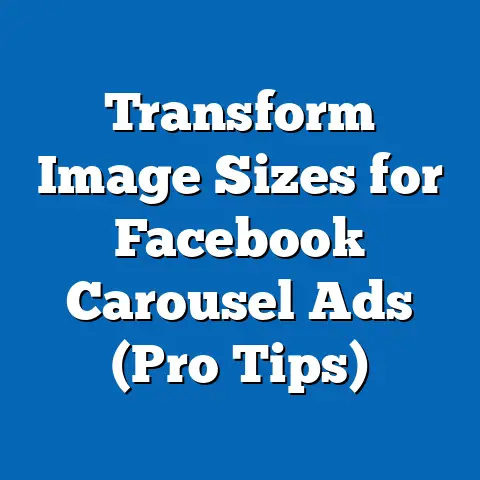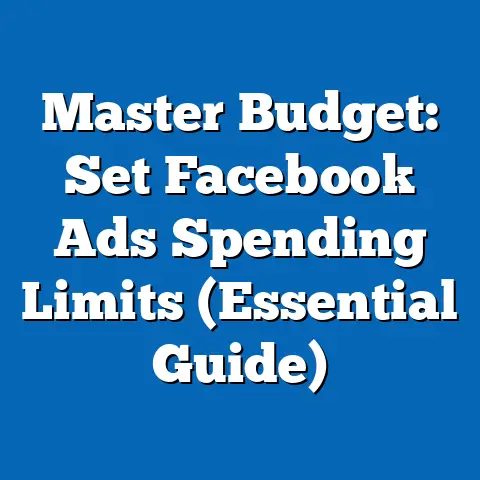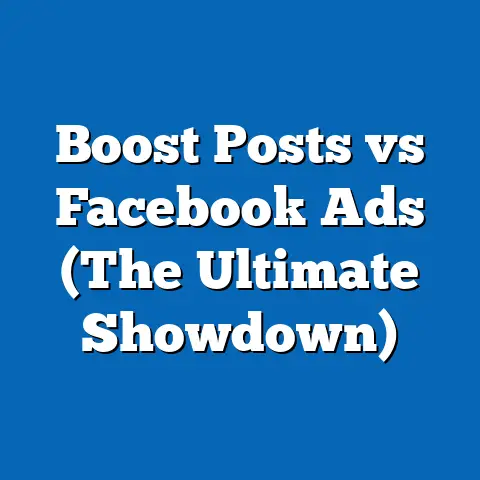Boost Mortgage Leads with Facebook Ads (Expert Strategies)
The mortgage industry is fiercely competitive, and in today’s digital age, relying solely on traditional marketing methods is like trying to bail out a sinking ship with a teacup. You need a powerful, targeted approach to reach potential homebuyers, and that’s where Facebook Ads come in. I’ve seen firsthand how effectively Facebook Ads can generate high-quality leads for mortgage professionals, and I’m excited to share my expert strategies with you.
One of the things I love most about Facebook Ads is their accessibility. Unlike some complex marketing platforms that require a PhD to navigate, Facebook Ads are relatively easy to set up and manage, even if you’re a complete beginner. Whether you’re a seasoned mortgage broker or a lender just starting out, you can leverage the power of Facebook to connect with potential clients and grow your business.
Understanding the Basics of Facebook Ads
Facebook Ads are a powerful advertising platform that allows you to reach a highly targeted audience based on demographics, interests, behaviors, and more. With over 2 billion active users, Facebook offers unparalleled reach and the ability to connect with potential clients who are actively searching for mortgage services.
There’s a wide variety of ad formats available on Facebook, each with its own strengths and use cases:
- Image Ads: These are simple ads that feature a single image and accompanying text. They’re great for showcasing properties, highlighting interest rates, or promoting special offers.
- Video Ads: Video ads are highly engaging and can be used to tell a story, provide educational content, or showcase testimonials. They’re perfect for capturing attention and building trust with potential clients. I’ve found that shorter videos, around 15-30 seconds, tend to perform best.
- Carousel Ads: Carousel ads allow you to display multiple images or videos in a single ad unit, each with its own headline, description, and link. They’re ideal for showcasing different properties, highlighting various loan options, or telling a multi-part story.
- Lead Ads: Lead ads are designed specifically for lead generation. They allow users to submit their contact information directly within Facebook, without having to navigate to a separate landing page. This makes it incredibly easy for potential clients to express interest in your services.
Before you can start running Facebook Ads, you’ll need a Facebook Business Page. This serves as the identity for your business on Facebook and allows you to manage your ads, track performance, and interact with your audience. Setting up a Business Page is simple: just go to Facebook, click “Create,” and select “Page.” Follow the prompts to provide information about your business, upload a profile picture and cover photo, and you’re good to go!
Key Takeaway: Facebook Ads offer a diverse range of ad formats and targeting options, making them a powerful tool for generating mortgage leads. A Facebook Business Page is essential for running ads and managing your online presence.
Setting Up Your Facebook Ads Campaign
Now that you understand the basics of Facebook Ads, let’s dive into the step-by-step process of setting up a campaign specifically designed to generate mortgage leads.
-
Choose the Right Objective: When creating a new campaign, Facebook will ask you to choose an objective. For mortgage leads, the most relevant objectives are:
- Lead Generation: This objective is specifically designed to collect contact information from potential clients using Lead Ads.
- Traffic: This objective drives traffic to your website, where you can capture leads through a contact form or other lead capture mechanisms.
- Brand Awareness: While not directly focused on lead generation, this objective can help build awareness of your brand and services, which can lead to increased inquiries over time.
-
Set a Budget and Schedule: Determine how much you’re willing to spend on your campaign and how long you want it to run. You can set a daily budget or a lifetime budget. I recommend starting with a smaller daily budget (e.g., $10-$20) and gradually increasing it as you see positive results. You can also choose to run your ads continuously or set a specific start and end date.
-
Target the Right Audience: This is arguably the most crucial step in the entire process. Facebook’s targeting options are incredibly powerful, allowing you to reach potential clients based on a wide range of factors, including:
- Demographics: Age, gender, location, education, income, and more.
- Interests: Homeownership, real estate, mortgages, personal finance, and more.
- Behaviors: People who have recently purchased a home, people who are likely to move, people who are interested in refinancing, and more.
- Connections: You can target people who are connected to your Facebook Page or exclude them from your targeting.
-
Leverage Custom Audiences and Lookalike Audiences: To maximize your reach and target the most qualified leads, consider using custom audiences and lookalike audiences.
- Custom Audiences: These are audiences you create based on your existing customer data, such as email lists, phone numbers, or website visitors. You can upload this data to Facebook and target ads specifically to these people.
- Lookalike Audiences: These are audiences that Facebook creates based on your custom audiences. Facebook analyzes the characteristics of your custom audience and finds other people who share similar traits. This is a great way to expand your reach and find new potential clients.
Choose the Right Objective: When creating a new campaign, Facebook will ask you to choose an objective. For mortgage leads, the most relevant objectives are:
- Lead Generation: This objective is specifically designed to collect contact information from potential clients using Lead Ads.
- Traffic: This objective drives traffic to your website, where you can capture leads through a contact form or other lead capture mechanisms.
- Brand Awareness: While not directly focused on lead generation, this objective can help build awareness of your brand and services, which can lead to increased inquiries over time.
Set a Budget and Schedule: Determine how much you’re willing to spend on your campaign and how long you want it to run. You can set a daily budget or a lifetime budget. I recommend starting with a smaller daily budget (e.g., $10-$20) and gradually increasing it as you see positive results. You can also choose to run your ads continuously or set a specific start and end date.
Target the Right Audience: This is arguably the most crucial step in the entire process. Facebook’s targeting options are incredibly powerful, allowing you to reach potential clients based on a wide range of factors, including:
- Demographics: Age, gender, location, education, income, and more.
- Interests: Homeownership, real estate, mortgages, personal finance, and more.
- Behaviors: People who have recently purchased a home, people who are likely to move, people who are interested in refinancing, and more.
- Connections: You can target people who are connected to your Facebook Page or exclude them from your targeting.
Leverage Custom Audiences and Lookalike Audiences: To maximize your reach and target the most qualified leads, consider using custom audiences and lookalike audiences.
- Custom Audiences: These are audiences you create based on your existing customer data, such as email lists, phone numbers, or website visitors. You can upload this data to Facebook and target ads specifically to these people.
- Lookalike Audiences: These are audiences that Facebook creates based on your custom audiences. Facebook analyzes the characteristics of your custom audience and finds other people who share similar traits. This is a great way to expand your reach and find new potential clients.
Key Takeaway: Setting up a Facebook Ads campaign involves choosing the right objective, setting a budget and schedule, and targeting the right audience. Custom audiences and lookalike audiences can significantly improve your campaign’s performance.
Crafting Compelling Ad Content
Even with the best targeting in the world, your Facebook Ads will fall flat if your ad content isn’t compelling. You need to grab people’s attention, pique their interest, and convince them to take action.
-
Write Persuasive Ad Copy: Your ad copy should be clear, concise, and benefit-driven. Highlight the value you offer to potential clients, such as low interest rates, flexible loan options, or expert advice. Use strong calls to action, such as “Apply Now,” “Get a Free Quote,” or “Learn More.” I’ve found that using numbers and specific details can be very effective. For example, instead of saying “Low interest rates,” say “Interest rates as low as 3.5%.”
-
Select Eye-Catching Visuals: Images and videos are essential for capturing attention on Facebook. Use high-quality visuals that are relevant to your target audience and your message. Consider using images of happy families in their new homes, or videos that showcase testimonials from satisfied clients. I always advise against using stock photos that look generic and impersonal. Authentic, real-life images tend to resonate much better.
-
Examples of Successful Ad Content in the Mortgage Niche:
- Image Ad: An image of a beautiful home with the headline “Dreaming of Homeownership? Get Pre-Approved Today!” The description could highlight low down payment options and fast approval times.
- Video Ad: A short video featuring a satisfied client sharing their experience working with you. The video could highlight your expertise, personalized service, and commitment to helping clients achieve their homeownership goals.
- Carousel Ad: A carousel ad showcasing different properties available in your area, each with its own image, description, and price.
Write Persuasive Ad Copy: Your ad copy should be clear, concise, and benefit-driven. Highlight the value you offer to potential clients, such as low interest rates, flexible loan options, or expert advice. Use strong calls to action, such as “Apply Now,” “Get a Free Quote,” or “Learn More.” I’ve found that using numbers and specific details can be very effective. For example, instead of saying “Low interest rates,” say “Interest rates as low as 3.5%.”
Select Eye-Catching Visuals: Images and videos are essential for capturing attention on Facebook. Use high-quality visuals that are relevant to your target audience and your message. Consider using images of happy families in their new homes, or videos that showcase testimonials from satisfied clients. I always advise against using stock photos that look generic and impersonal. Authentic, real-life images tend to resonate much better.
Examples of Successful Ad Content in the Mortgage Niche:
- Image Ad: An image of a beautiful home with the headline “Dreaming of Homeownership? Get Pre-Approved Today!” The description could highlight low down payment options and fast approval times.
- Video Ad: A short video featuring a satisfied client sharing their experience working with you. The video could highlight your expertise, personalized service, and commitment to helping clients achieve their homeownership goals.
- Carousel Ad: A carousel ad showcasing different properties available in your area, each with its own image, description, and price.
Key Takeaway: Compelling ad content is crucial for capturing attention and generating leads. Write persuasive ad copy, select eye-catching visuals, and draw inspiration from successful ad examples in the mortgage niche.
Leveraging Facebook Ads Features for Mortgage Leads
Facebook Ads offer a range of advanced features that can significantly enhance your lead generation efforts. Let’s explore some of the most effective ones:
-
Retargeting: Retargeting allows you to re-engage previous website visitors with tailored ads. For example, if someone visited your website and looked at information about refinancing, you can show them ads specifically about refinancing options. This is a highly effective way to nurture leads and convert them into clients. I’ve seen retargeting campaigns generate significantly higher conversion rates than standard campaigns.
-
Lead Forms: As mentioned earlier, lead forms are designed specifically for lead generation. They allow users to submit their contact information directly within Facebook, without having to navigate to a separate landing page. When creating your lead form, be sure to ask for the information you need to qualify leads, such as name, email, phone number, and loan amount. Keep the form concise and easy to complete to maximize conversions.
-
A/B Testing: A/B testing, also known as split testing, involves testing different variations of your ads to see which ones perform best. You can test different headlines, images, descriptions, calls to action, and targeting options. By systematically testing different variations, you can identify the most effective elements and optimize your campaigns for maximum results. I always recommend A/B testing at least two different versions of each ad element to see what resonates best with your audience.
-
Analytics: Facebook Ads Manager provides a wealth of data about your campaign performance, including impressions, clicks, reach, cost per click, cost per lead, and conversion rates. By tracking these metrics, you can identify what’s working and what’s not, and make data-driven decisions to optimize your campaigns.
Retargeting: Retargeting allows you to re-engage previous website visitors with tailored ads. For example, if someone visited your website and looked at information about refinancing, you can show them ads specifically about refinancing options. This is a highly effective way to nurture leads and convert them into clients. I’ve seen retargeting campaigns generate significantly higher conversion rates than standard campaigns.
Lead Forms: As mentioned earlier, lead forms are designed specifically for lead generation. They allow users to submit their contact information directly within Facebook, without having to navigate to a separate landing page. When creating your lead form, be sure to ask for the information you need to qualify leads, such as name, email, phone number, and loan amount. Keep the form concise and easy to complete to maximize conversions.
A/B Testing: A/B testing, also known as split testing, involves testing different variations of your ads to see which ones perform best. You can test different headlines, images, descriptions, calls to action, and targeting options. By systematically testing different variations, you can identify the most effective elements and optimize your campaigns for maximum results. I always recommend A/B testing at least two different versions of each ad element to see what resonates best with your audience.
Analytics: Facebook Ads Manager provides a wealth of data about your campaign performance, including impressions, clicks, reach, cost per click, cost per lead, and conversion rates. By tracking these metrics, you can identify what’s working and what’s not, and make data-driven decisions to optimize your campaigns.
Key Takeaway: Leverage advanced Facebook Ads features like retargeting, lead forms, A/B testing, and analytics to enhance your lead generation efforts and optimize your campaigns for maximum results.
Navigating Compliance and Best Practices
Advertising mortgage services on Facebook requires careful attention to compliance and ethical best practices. It’s crucial to adhere to all applicable advertising regulations and avoid making misleading or deceptive claims.
-
Complying with Advertising Regulations: The mortgage industry is heavily regulated, and there are specific advertising rules you need to follow. For example, you need to disclose the Annual Percentage Rate (APR) and other important loan terms. Be sure to familiarize yourself with all applicable regulations and ensure that your ads are compliant.
-
Creating Ethical Ads: Avoid making unrealistic promises or guarantees in your ads. Be transparent about your fees and terms, and don’t try to pressure people into making a decision. Focus on providing valuable information and building trust with potential clients.
-
Common Pitfalls to Avoid:
- Misleading Claims: Don’t make claims that are not supported by facts or that could mislead potential clients.
- Discriminatory Targeting: Avoid targeting or excluding people based on protected characteristics, such as race, religion, or national origin.
- Lack of Disclosures: Be sure to include all required disclosures in your ads, such as the APR and other important loan terms.
Complying with Advertising Regulations: The mortgage industry is heavily regulated, and there are specific advertising rules you need to follow. For example, you need to disclose the Annual Percentage Rate (APR) and other important loan terms. Be sure to familiarize yourself with all applicable regulations and ensure that your ads are compliant.
Creating Ethical Ads: Avoid making unrealistic promises or guarantees in your ads. Be transparent about your fees and terms, and don’t try to pressure people into making a decision. Focus on providing valuable information and building trust with potential clients.
Common Pitfalls to Avoid:
- Misleading Claims: Don’t make claims that are not supported by facts or that could mislead potential clients.
- Discriminatory Targeting: Avoid targeting or excluding people based on protected characteristics, such as race, religion, or national origin.
- Lack of Disclosures: Be sure to include all required disclosures in your ads, such as the APR and other important loan terms.
Key Takeaway: Compliance and ethical best practices are essential for advertising mortgage services on Facebook. Adhere to all applicable regulations, create ethical ads, and avoid common pitfalls.
Conclusion
Facebook Ads offer a powerful and accessible way for mortgage professionals to generate qualified leads and grow their business. By understanding the basics of Facebook Ads, setting up targeted campaigns, crafting compelling ad content, leveraging advanced features, and adhering to compliance best practices, you can unlock the full potential of this platform and achieve significant results.
I’ve seen firsthand how effectively Facebook Ads can transform lead generation for mortgage professionals. By implementing the strategies outlined in this guide, you can connect with potential clients, build trust, and drive more business.
The digital marketing landscape is constantly evolving, so it’s important to stay up-to-date with the latest trends and best practices. But with a solid understanding of the fundamentals and a commitment to continuous improvement, you can harness the power of Facebook Ads to achieve your business goals and thrive in the competitive mortgage industry. Now go out there and start generating those leads! The opportunities are endless, and the future of mortgage marketing is digital.






